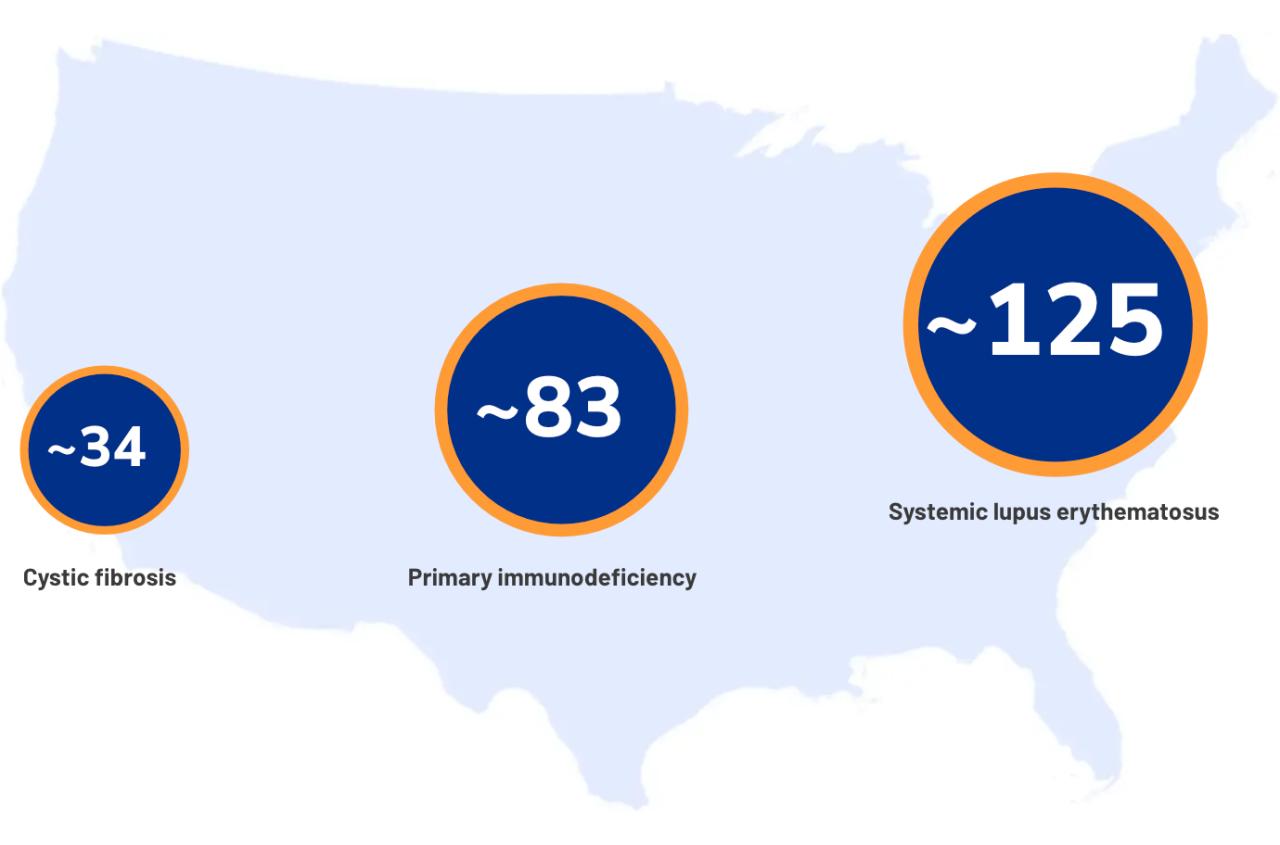GAMMAGARD LIQUID [Immune Globulin Infusion (Human)] 10% Solution is indicated as a replacement therapy for primary humoral immunodeficiency (PI) in adult and pediatric patients ≥2 years.
Identifying Primary Immunodeficiency (PI)

About PI
PI is an umbrella term for more than 550 disorders in which genetic or congenital defects in the immune system cause an increased susceptibility to infections. PI can affect anyone, regardless of age or gender. Although some types of PI are diagnosed at birth or soon after, other types are often not recognized and diagnosed until later in life.1
US population prevalence per 100,000 people2-4
Despite having similar prevalence to better-known genetic disorders, PI often goes unrecognized.

Diagnostic delay for patients with PI
People with PI may live many years with recurrent infections before they are accurately diagnosed.5
Average time from symptom onset to PI diagnosis*
In addition to clinical complications, patients with undiagnosed PI tend to have a poorer quality of life. In the years before their diagnosis, these patients may experience one or more of the following6,7†:
- Acute and severe infections
- Days with chronic infections
- Visits to physicians and/or emergency departments
- Days spent in the hospital
- Days of school and/or work missed
- End organ damage
| * | According to the 2023 Immune Deficiency Foundation (IDF) national survey among 1,177 people with PI, the average time from symptom onset to diagnosis is 25 years. |
| † | According to a US Jeffrey Modell Centers survey (N=10,192). |
What may cause underdiagnosis?
There are as many as 500,000 undiagnosed cases of PI in the US alone. However, awareness of PI is low among both physicians and the general public, and many patients are left undiagnosed.6 Reasons for this may include:
- A lack of awareness of PIs and/or their management6
- The masking of symptoms due to frequent antibiotic use7
- Symptoms may present differently to different specialists over a number of years7
- The lengthy process of confirmation, which includes many tests and consultations8
Recognizing PI symptoms1,9
PI can hide among other conditions. Despite its complex presentations, physicians may be able to identify PI using the following criteria for patients who present with an infection that is:
RECURRENT
keeps coming back
PERSISTENT
won’t completely clear up or clears very slowly
UNUSUAL
resulting by an uncommon organism
SEVERE
requiring hospitalization or intravenous antibiotics
Shared by family members
others in your family have or have had a similar susceptibility to infection
10 warning signs of PI in adults
PI may be suspected in adults who present with 2 or more of the following warning signs10:
- Two or more new ear infections within 1 year
- Two or more serious sinus infections within 1 year, in the absence of allergy
- One pneumonia per year for more than 1 year
- Chronic diarrhea with weight loss
- Recurrent viral infections (cold, herpes, warts, condyloma)
- Recurrent need for intravenous antibiotics to clear infections
- Recurrent, deep abscesses of the skin or internal organs
- Persistent thrush or fungal infection on skin or elsewhere
- Infection with normally harmless tuberculosis-like bacteria
- A family history of PI
10 warning signs of PI in children
PI may be suspected in children who present with 2 or more of the following warning signs11:
- Four or more new ear infections within 1 year
- Two or more serious sinus infections within 1 year
- Two or more months on antibiotics with little effect
- Two or more pneumonias within 1 year
- Failure of an infant to gain weight or grow normally
- Recurrent, deep skin or organ abscesses
- Persistent thrush in mouth or fungal infection on skin
- Need for intravenous antibiotics to clear infections
- Two or more deep-seated infections including septicemia
- A family history of PI
What is the diagnostic process?
If you have a patient you suspect may have PI, the AAAAI and ACAAI guidelines recommend that you consider12:
- An immunological evaluation, beginning with a thorough medical history and physical exam including family history
- A complete blood count (CBC) with manual differential
- Total immunoglobulin levels (IgG, IgM, IgA)
- Antibody response to protein or polysaccharide vaccines provides important diagnostic information
AAAAI=American Academy of Allergy, Asthma & Immunology; ACAAI=American College of Allergy, Asthma and Immunology.
How are results evaluated
Quantitative measurement determines the concentration of IgG, IgM, and IgA in serum.
- Levels below the normal range for a patient raise the index of suspicion for an antibody deficiency8
- However, a patient may present with normal levels and still have an antibody deficiency13
Qualitative measurement determines the antibody response to the antigenic challenge of vaccines.14
- Protein (eg, diphtheria and tetanus): T-dependent antigens that require T-cell and B-cell cooperation
- Polysaccharide (pneumococcal): T-independent antigens. This measurement serves 2 purposes: it determines patient capability of mounting protective antibody responses and determines the magnitude of the response
Some people diagnosed with PI can have normal IG levels, such as patients with SAD.14 Because of this, vaccine response testing is needed to confirm a diagnosis.8
Laboratory findings in common types of PI8
| Diagnosis | IgG | IgA | Vaccine response | B cells |
|---|---|---|---|---|
| Specific antibody deficiency (SAD) | Normal | Normal | Low | Normal |
| Common variable immunodeficiency (CVID) | Low | Low | Low | Normal or Low |
| Hypogammaglobulinemia | Low | Normal or Low | Normal | Normal or Low |
Access to GAMMAGARD LIQUID resources
Sign up for updates on GAMMAGARD LIQUID for PI.
References:
- About primary immunodeficiencies. Immune Deficiency Foundation. Accessed March 13, 2025. https://primaryimmune.org/understanding-primary-immunodeficiency/what-is-pi
- Boyle JM, Buckley RH. Population prevalence of diagnosed primary immunodeficiency diseases in the United States. J Clin Immunol. 2007;27(5):497-502.
- Mirtajani SB, Farnia P, Hassanzaad M, et al. Geographical distribution of cystic fibrosis; the past 70 years of data analysis. Biomed Biotechnol Res J. 2017;1(2):105-112.
- Rees F, Doherty M, Grainge MJ, et al. The worldwide incidence and prevalence of systemic lupus erythematosus: a systemic review of epidemiological studies. Rheumatology. 2017;56(11):1945-1961.
- 2023 IDF National Immunoglobulin Treatment Survey. Immune Deficiency Foundation. Accessed March 26, 2025. https://www.primaryimmune.org/sites/default/files/2023_IDF_National_Immunoglobulin_Treatment_Survey.pdf
- Modell F, Puente D, Modell V. From genotype to phenotype: further studies measuring the impact of a physician education and public awareness campaign on early diagnosis and management of primary immunodeficiencies. Immunol Res. 2009;44(1-3):132-149.
- Verbsky JW, Grossman WJ. Cellular and genetic basis of primary immune deficiencies. Pediatr Clin North Am. 2006;53(4):649-684.
- Bonilla FA, Khan DA, Ballas ZK, et al. Practice parameter for the diagnosis and management of primary immunodeficiency. J Allergy Clin Immunol. 2015;136(5):1186-1205.e2078.
- Younger MEM, ed. IDF Guide for Nurses. Immunoglobulin Therapy for Primary Immunodeficiency Diseases. 4th ed. Immune Deficiency Foundation; 2016:1-59.
- 10 warning signs of primary immunodeficiency for adults. Jeffrey Modell Foundation. Accessed March 13, 2025. https://res.cloudinary.com/info4pi/image/upload/v1724180660/JMF_10_Signs_Adult_Poster_080724_v2_b5cdc19478.pdf
- 10 warning signs of primary immunodeficiency. Jeffrey Modell Foundation. Accessed March 27, 2025. https://res.cloudinary.com/info4pi/image/upload/v1724180661/JMF_10_Signs_Illustrated_080724_v2_a9b4bb218e.pdf
- Diagnostic & Clinical Care Guidelines for Primary Immunodeficiency Diseases. 3rd edition. Immune Deficiency Foundation. Accessed September 1, 2020. https://primaryimmune.org/sites/default/files/publications/2015-Diagnostic-and-Clinical-Care-Guidelines-for-PI_1.pdf
- Orange JS. Clinical update in immunoglobulin therapy for immunodeficiency diseases. Immune Deficiency Foundation. March 16, 2011. Accessed May 19, 2025. https://primaryimmune.org/resources/print-material/clinical-update-immunoglobulin-therapy-for-primary-immunodeficiency-diseases
- Orange JS, Ballow M, Stiehm ER, et al. Use and interpretation of diagnostic vaccination in primary immunodeficiency: a working group report of the Basic and Clinical Immunology Interest Section of the American Academy of Allergy, Asthma & Immunology. J Allergy Clin Immunol. 2012;130(suppl 3):S1-S24.